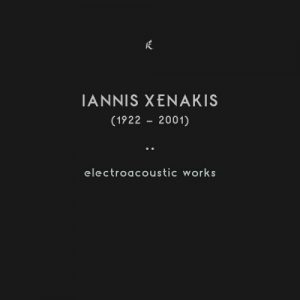 Of course we’re all knee deep in re-issues of unheard electroacoustic works at this point in history, but Iannis Xenakis is something special-er than merely one of the bods who had a go at electronic means to produce music.
Of course we’re all knee deep in re-issues of unheard electroacoustic works at this point in history, but Iannis Xenakis is something special-er than merely one of the bods who had a go at electronic means to produce music.
A lot of composers went through periods of giving it a go and ultimately not finding their voice in it — while I’d personally say György Ligeti was one of the finest voices of the twentieth century, his electronic experiments don’t really bear revisiting. Not so for big Ianni, whose music for traditional instruments remains some of the more extreme works in composition. I remember a Prom, several million years ago, where audiences were aghast at a punishingly loud percussion piece (Pléiades, if memory serves).
Xenakis is challenging on a few axes — I have two solo violin pieces of his (Mikka I and II) and they are unplayable. That is the case for lots of things — I’m not a great violinist — but for extreme sonic results, Xenakis puts astonishing demands on his players. One of the Mikkas has two distinct staves for directions per string — that is to say, two fingers move in contrary directions such that it’s easier to notate as if it’s two instruments, but he’s very specific about it being for one player. And then the rhythm is achingly precise, and the tones are also precise, down to fractions of a note.I say this to qualify Xenakis in a few ways — he’s a very hard composer in lots of ways, and puts astonishing demands on his performers. That he successfully turned his hand to electroacoustic composition as well is interesting, in that this isn’t music which stands in mechanically where human players cannot. It’s difficult to say how radical this music is 2022 — a time in which plenty of electronic music traditions are entirely saturated with extended tours of sonority and non-rhythmic / non-melodic music — but it’s certainly greater than the sum of its sonorities.
The set is roughly chronological, covering 1957-1992. There are wee clusters of electronic stuff in 1957-1962 and 1987-1992 (with outbursts in ’69 / ’72 / ’78), which gives the impression electronic music wasn’t an overriding concern — his list of works has entries for most years from ’53 to ’97 (his death in 2001). Listening to these works, it’s perhaps a sense that, in challenging what sonorities acoustic instruments could produce, it was only so often his vision required electronic means. A for instance — Concret PH (1958) shares conceptual and sonic realisation with Bohor (1962). The former is a fearsomely cut-up sample of burning coal that ultimately sounds like a roaring glass fire. It is beautiful and quite uncanny, and no doubt incredibly laborious to create. Unusually for Xenakis (or at least the Xenakis I know), the composition seems to have been intuitive, cuts here and there until completion, rather than with a specific method in hand.Bohor shares a sonic and methodical space — apparently the source samples in Bohor of Laotian mouth organs, Byzantine chant, Oriental bracelets and piano. But the sound itself dotes around a complex noise of incredibly short, noisy sounds too fractured to pin down except as “noise” — again, more like a roaring fire than evoking its source. This is counterposed with a chord cycle, presumably from the piano, but nothing so evocative as a clear attack (possibly the sound of note decay?).
The counterpoint between a very noisy clatter, which cedes to a wind-like rush, and the funereal organ-like chords makes for a chaotic piece, but all the more beautiful for the allusion to control with the chords. It feels to me like the effect, or experiment, of Concret PH is giving part of the voice to the composition of Bohor.Xenakis is often mentioned in the same breath as noise music and that gets a “yeah… but” from me — my impression is that for all the constructed chaos of Xenakis’s music, and the severe and extreme sonorities and timbres, he never just gives over to mere sound — there’s always a structure, or an impression of a structure, or a sound distended just so. It’s not libidinal explosions, to my mind, though he clearly has an affection for timbre.
Xenakis is possibly the composer of his era who stands solitary in terms of voice — he’s somehow not part of the “let sounds be” of the John Cage confluence, while also not part of the grandiosity of Karlheinz Stockhausen (Cage a decade older, Stockhausen eight years younger). He’s certainly not in the same continuum as the modernisms of Arnold Schoenberg or Olivier Messiaen — both old world, however radical their output (very, btw) — and while it’s tempting to to draw comparisons with Ligeti (a year Xenakis’s junior), Ligeti’s tonalities were altogether more frail, though no less sumptuous.
Possibly the big difference between Xenakis and other composers of the avant-garde (such as it is) is in his source materials. Both as inspiration — Xenakis was drawing on architecture and physics and “hard” sciences — and in terms of what he was using. While Concret PH and Bohor elide their sonic sources, Hibiki Hana-ma (1969) draws on “traditional” orchestral instruments — not quite a collage, but not quite a demolition; poised between representative sounds and sonic effect, but never slipping comfortably into either realm. Elsewhere on this complex elision of transparent sources gives way to more direct synthesis — Mycenae Alpha could easily be a later Bernard Parmegiani piece, all swooping bees and dial-up alike tones, while the intensive acoustic textures and collaging of Polytope de Cluny drifts close to the sort of acoustic musique concrète that would later beguile Helmet Lachenmann. Polytope de Cluny is perhaps an oddity, insofar as its complexity and variegation is not quite that of his orchestral works — the tapes get to work less hard than his musicians. It’s similar in a sense to this collections’ earliest work, Diamorphoses — not perhaps as inclined towards stereo swoops, but definitely a treat for decent headphones.Possibly the sets’ two centrepieces — or at least the longest — show a breadth of voices to his electroacoustic works. Persepolis (1972) ploughs a furrow similar to his orchestral work, moving from plane takeoff sounds with grinding and squeeling metal and a distant, warming analogue buzz, while Le Légende d’Eer (1978) moves through a drift of synthesised sounds from thin sine-like waves to bubbling computer sounds to the inevitable synthesised angry bees. While the latter is more clearly synthesised, its distribution of sampled sounds (again, often similar to the unplacable cuts of Concret PH) is judicious.
Later on still we get works like Gendy 3 (1991) — on the one hand, a faintly familiar sound like Clangers in a microwave; on the other, an apparently cautious and careful exposition of tuning systems more easily available to electronic music. As with the whole of the set, pinning down sources just by listening is troublesome, and the overwhelming sense is that working electronically, big Ianni had a very different flex to other composers — while Pierre Schaeffer had a consistent voice and sonorities he would list towards, Xenakis’s electronic work feels ultimately like it dotes on the contrast of timbres and sonorities. It’s not just samples and bleeps or just cuts and complements, it’s a deft weaving of source and synthesised material. So the long and the short of it is that it’s a real pleasure to have a proper collection of Xenakis’s electronic work — the packaging is lovely, the accompanying text useful, the works tensely diverse. There’s the distinct impression that these aren’t merely “experimental” works, or that they lean on the shock of the new. Rather, they’re putting his electronic work on a level field with his entirely formidable work for “traditional” instruments.Definitely one for the electroacoustic lover in your life.
-Kev Nickells-



